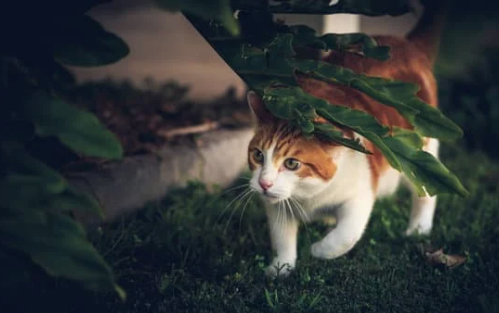
Have you ever wondered how your cat experiences the world? From lightning-fast reflexes to super-sensitive whiskers, cats have remarkable senses that help them navigate, communicate, and even show affection. Let’s explore how your furry friend sees, hears, smells, tastes, and feels their surroundings.
Sight
Cats have an extraordinary way of seeing the world. At the back of their retina is an extra layer of cells called the tapetum lucidum, which reflects light so it can be detected more efficiently. This clever adaptation is also responsible for that eerie greenish glow you sometimes see when shining a light on your cat in a dark room. While cats are not completely colorblind, they mostly perceive the world in shades of blue, yellow, and gray, missing reds and greens. They are incredibly fast at detecting movement, reacting far quicker than humans, and their slit pupils can expand to let in much more light than ours, giving them a huge advantage in darkness and low-light conditions. On the flip side, cats have poor detail vision and struggle with objects up close—a fact you may notice when trying to point them toward a treat right under their nose.
Hearing
Cats have an equally impressive sense of hearing. While they detect low-pitched sounds about as well as humans, they excel at hearing high-pitched noises and can even pick up sounds in the ultrasonic range. Their ears are marvels of engineering, able to swivel like tiny radar dishes to pinpoint the source of a sound. Each ear registers sounds slightly differently, helping your cat quickly figure out the distance and direction of what they’re hearing. They are particularly tuned in to high-pitched, fleeting sounds, like the squeaks of rodents or rustling leaves. Some cats can even hear noises from electronic devices that are inaudible to us, though whether they find these sounds bothersome varies from cat to cat.
Touch
With close-up vision being limited, cats rely heavily on touch to explore the world around them. Their whiskers are far more than cute facial features—they are highly sensitive tools connected to nerves that help cats gauge the width of openings, detect air currents, measure pressure, and sense how close objects are. In addition to their facial whiskers, cats have them above their eyes, on their cheeks, and even on the backs of their front legs. Their paws are also incredibly sensitive, which is why many cats dislike having them handled. Each claw contains nerve endings that provide detailed information about the shape and texture of whatever lies beneath, especially if it’s moving.
Smell
A cat’s sense of smell is believed to rival a dog’s and may even excel at distinguishing subtle differences between scents. Cats leave scent “calling cards” for other cats using glands on their chin, face, and paws, and also through urine and secretions from their anal glands. When a cat encounters an especially interesting scent, it will lift its lips and hold its mouth open, directing the scent over a special organ in the roof of the mouth called the vomeronasal organ. This is most commonly used to investigate other cats, but they may apply it to any intriguing smell. Unlike humans, who rely primarily on vision to recognize one another, cats rely heavily on scent. Your feline friend knows and loves your unique smell far more than they notice your facial features.
Taste
Cats have a unique approach to taste as well. They lack the taste buds to detect sweetness, but they are very sensitive to bitterness—which is why most oral medications taste especially unpleasant to them. When deciding what to eat, cats rely more on other senses, such as smell, texture, and temperature. In fact, a cat whose sense of smell is temporarily impaired by illness may refuse to eat altogether—but warming their food can often make it more appealing and encourage them to eat.
Understanding Your Kitty’s World
Your cat’s senses are truly remarkable, giving them a unique perspective on the world around them. From the way they track a rustling leaf to the way they nuzzle you with their whiskers, every sight, sound, and scent shapes their daily experiences—and their bond with you. Understanding how your kitty senses the world can help you better meet their needs, enrich their environment, and appreciate the little ways they show affection every day.







